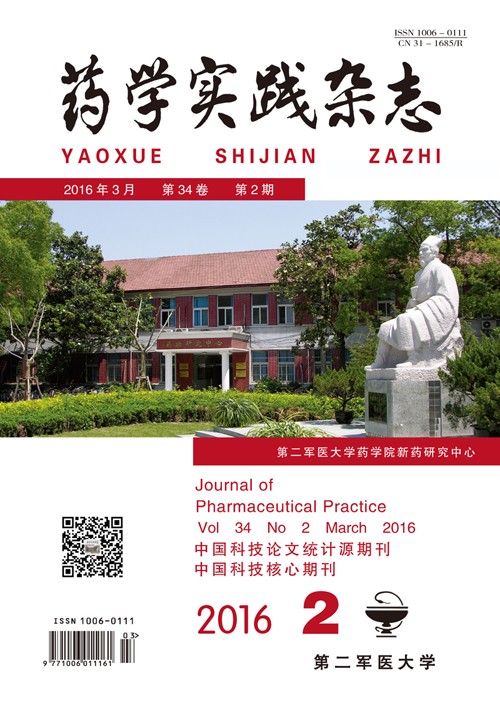MA Zongqiang, AN Hongliang. Application analysis of antihypertensive drugs in outpatient[J]. Journal of Pharmaceutical Practice and Service, 2016, 34(2): 188-190,192. doi: 10.3969/j.issn.1006-0111.2016.02.024
| Citation:
|
MA Zongqiang, AN Hongliang. Application analysis of antihypertensive drugs in outpatient[J]. Journal of Pharmaceutical Practice and Service, 2016, 34(2): 188-190,192. doi: 10.3969/j.issn.1006-0111.2016.02.024
|
Application analysis of antihypertensive drugs in outpatient
- Received Date: 2015-08-24
- Rev Recd Date:
2016-01-18
-
Abstract
Objective To study the application of outpatient oral antihypertensive drugs in Shanghai Meishan Hospital, and provide a guide for clinical rational drug use. Methods The utilization of antihypertensive drugs in outpatients of our hospital was analyzed statistically by using defined daily dose(DDD) recommended by WHO. Results 1 The most commonly used antihypertensive drugs in outpatients was calcium antagonist(51.98%), followed by angiotensin receptor blockers(16.60%), fixed-dose combination(13.23%), β-blockers(11.93%), diuretics(3.67%), angiotensin-converting enzyme inhibitors(2.40%), and α,β-blockers(0.19%). 2 The combination therapy was fewer in outpatients than monotherapy(32.99% versus 67.01%). Conclusion The application of antihypertensive drugs is basically reasonable in outpatient of our hospital, but the combination therapy was inadequate.
-
References
|
[1]
|
林凡礼,战义强,贾贡献,等.中国门诊高血压患者血压达标现状及影响因素分析[J].中华高血压杂志,2013,21(2):170-174. |
|
[2]
|
中国高血压防治指南修订委员会.中国高血压防治指南2010[J].中华心血管杂志,2011,39(7):579-616. |
|
[3]
|
James PA,Oparil S,Carter BL,et al.2014 evidence-based guideline for the management of high blood pressure in adults:report from the panel members appointed to the Eighth Joint National Committee(JNC8)[J].JAMA,2014,311(5):507-520. |
|
[4]
|
Lindholm LH,Carlberg B,Samuelsson O.Should beta blockers remain first choice in the treatment of primary hypertension? A meta-analysis[J].Lancet,2005,366(9496):1545-1553. |
|
[5]
|
Bradley HA,Wiysonge CS,Volmink JA,et al.How strong is the evidence for use of beta blockers as first-line therapy for hypertension? Systematic review and meta-analysis[J].J Hypertens,2006,24,(11):2131-2141. |
|
[6]
|
Ma W,Zhang Y.Low rate of resistant hypertension in Chinese patients with hypertension:an analysis of the HOT-CHINA study[J].J Hypertens,2013,31(12):2386-2390. |
|
[7]
|
廖梅,陈玲.琥珀酸美托洛尔缓释片对高血压患者血压变异性的影响[J].国际医药卫生导报,2012,18(11):1618. |
|
[8]
|
胡大一,刘力生,余金明,等.中国门诊高血压患者治疗现状登记研究[J].中华心血管病杂志,2010,38(3):230-238. |
|
[9]
|
Brenner R,Waeber B,Allemann Y.Medical treatment of hypertension in Switzerland.The 2009 Swiss Hypertension Survey(SWISSHYPE)[J].Swiss Med Wkly,2011,141(w13169):1-7. |
|
[10]
|
Clement YN,Ali S,Harripaulsingh S,et al.Drug prescribing for hypertension at primary healthcare facilities in Trinidad[J].West Indian Med J,2012,61(1):43-48. |
|
[11]
|
秦际芳.氯沙坦钾氢氯噻嗪片治疗老年原发性高血压疗效观察[J].慢性病学杂志,2014,15(3):220-221. |
|
[12]
|
潘华兴,宁观林,林宇彪.氯沙坦钾氢氯噻嗪片治疗老年原发性高血压的研究[J].齐齐哈尔医学院学报,2014,35(8):1128-1129. |
|
[13]
|
袁静平.缬沙坦/氢氯噻嗪治疗轻中度原发性高血压患者疗效和安全性[J].中国医药导刊,2014,16(2):280-281. |
|
[14]
|
姜忠梅,李红霞,卢冬喜.氯沙坦钾氢氯噻嗪片治疗高血压合并2型糖尿病的临床研究[J].中国临床医生,2014,42(5):56-57. |
|
[15]
|
肖玉光,邓伟峰.非洛地平、缬沙坦分别联合氢氯噻嗪治疗老年ISH的疗效及安全性研究[J].重庆医学,2014,43(6):725-728. |
-
-
Proportional views

-







 DownLoad:
DownLoad: